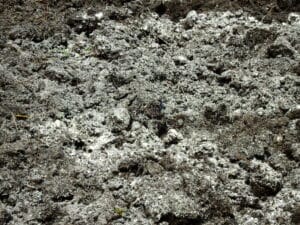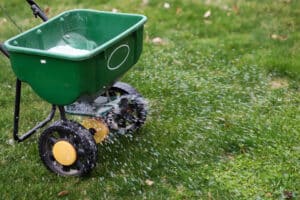When fall and peak growing season come to an end, consider a final fertilizer application to prepare your lawn for the harsh winter months. This preventive measure can help your lawn survive the cold’s damaging effects and help it thrive again when spring arrives.
In our guide, we’ll break down the benefits of winter fertilizers and offer tips on how to select the right one for your specific type of grass.
Find Lawn Help
- See our list of top lawn care companies based on in-depth research.
- Select the company that best meets your needs.
- Get a free, no-obligation quote for your home.
Get a Quote From Lawn Professionals Near You
Compare quotes from local pros

Lime Soil Amendment

Lawn Fertilization
What Is Winter Fertilizer?
A winter fertilizer, also known as a winterizer, is a lawn care treatment applied to grass in the late fall to encourage food storage in the winter and proper root system growth in the spring. This type of fertilizer is distinct from fall lawn treatments, which immediately encourage root growth and are applied before a winter fertilizer.
Quick Tip
- Winter fertilizers should be applied after your healthy lawn stops growing, when it’s green on top and active below the surface. These fertilizers are a vital last step in your annual lawn care maintenance, ensuring that the grass stays healthy when dormant.
Why Should You Apply Winter Fertilizer?
Winter fertilizer can help maintain the health of your lawn during the colder months. Here are a few of its benefits:
- Root development: The potassium in winter fertilizer promotes root development. A stronger root system enables your lawn and plants to withstand freezing temperatures.
- Cold resistance: Applying winter fertilizer helps plants build up a reserve of essential nutrients. This allows them to resist the cold, which is especially important for cool-season grasses.
- Disease and pest resistance: A plant stocked with nutrients is better equipped to resist disease and pests.
- Jump-start spring growth: Extra nutrients throughout the winter ensure that plants come out of dormancy and quickly green in the spring.
What’s the Best Way To Use Winter Fertilizer on Your Lawn?
Most winter fertilizers are applied after the last mow of the fall season, when your lawn is done growing and preparing for dormancy. At this point, your lawn can take in the nitrogen provided by the fertilizer and store it for later use.
The prime application is usually around November, though people living in some northern states may need to apply the fertilizer a bit earlier. Waiting too long may cause your grass to succumb to mold and ice issues in the winter, while applying too early may prevent your lawn from reaching its full potential. It’s also best to apply winter fertilizer the day after rain when the soil is moist but at least a few days before the next rain. This ensures that the winterizer doesn’t get washed away.
How Can You Choose the Best Winter Fertilizer?
A quality winter fertilizer incorporates two main nutrients: nitrogen (N) and potassium (K). Nitrogen helps restore your lawn’s carbohydrates, ensuring it has enough food to last through the colder winter and spring months. Potassium also provides your grass with nutrients, helping it survive cold-weather stressors like stress and mold.
Most winterizers have a 2:1 ratio of nitrogen to potassium. This proportion of essential nutrients helps give your lawn the proper combination of food storage and energy. It’s also important that your fertilizer consists of a water-soluble, quick-release formula for nitrogen nutrients. You can check the ingredients of a winterizer by reading the information listed on its bag.
Important Tips for Using Winter Fertilizer
While applying a winter fertilizer is similar to many other lawn treatments, there are a few things to consider. Here are some important tips for using winter fertilizer:
- Conduct a soil test before application: Before purchasing and applying winterizer, conduct a soil test to determine its potassium levels. If your soil displays adequate levels, you may not need to give it more potassium. While soil tests can be done on your own, you may want to consider hiring a lawn care service such as TruGreen to ensure that tests are conducted properly. Learn more about TruGreen in our in-depth review.
- Inspect the fertilizer’s ratio: While nitrogen and potassium are essential for winterizers, many also include phosphorus (P). Some of the best winter lawn fertilizers incorporate a formula with an NPK ratio of 16-4-8.
- Don’t apply winterizer too late: Generally, winter fertilizer should be applied in November or earlier, depending on your climate. Try to avoid applying in early December, as the nutrients within the formula may not take hold in time to protect the grass from harsh conditions.
- Use less fertilizer than the recommended amount: Use around 1/3 to 1/2 of the amount of fertilizer recommended on the package. This saves you money on application and prevents overfertilizing.
FAQs About Winter Fertilizers
Is winter fertilizer necessary?
A winter fertilizer is one of the most important lawn treatments since it protects grass during the winter and prevents unnecessary lawn damage. However, if you feed your lawn with fertilizer and compost during the warmer months or have a lawn with an adequate amount of potassium, you may not need this treatment. A new lawn can be vulnerable to extreme weather and might require even greater protection than an established lawn.
When should I apply winter fertilizer?
Apply a winter fertilizer to your lawn when it’s finished growing but not yet dormant underneath the surface. This is around November for many parts of the U.S., though it may be time to apply sooner if you live in a cold climate.
What is the difference between fall fertilizer and winter fertilizer?
The composition of a fall fertilizer is a bit different than its winter counterpart. While both fertilizers contain potassium, winterizers usually have a higher amount of this mineral to sustain your grass when the ground freezes.





